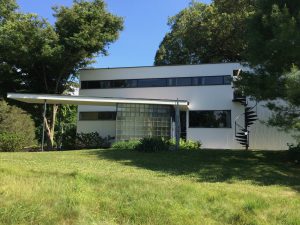 In 1919, Walter Gropius founded the Bauhaus, a German school of design combining art, crafts, and industrial technology. This modern form of design favored clean lines rather than ornamentation – creating elegance in practicality, economy of form, and attention to materials. The Nazis, however, did not favor this minimalist school of design, and closed the school in 1933.
In 1919, Walter Gropius founded the Bauhaus, a German school of design combining art, crafts, and industrial technology. This modern form of design favored clean lines rather than ornamentation – creating elegance in practicality, economy of form, and attention to materials. The Nazis, however, did not favor this minimalist school of design, and closed the school in 1933.
When Mr. Gropius was offered a teaching position at the Harvard Graduate School of Design, the German government allowed him to accept the position since it would be prestigious to have a German teaching at Harvard. Mr. Gropius became the Chairman of the Department of Architecture in the Graduate School of Design at Harvard in 1938.
Mr. Gropius and his wife, Ise, arrived in the United States in 1937 with only their furniture, books, and papers. The Nazi government did not allow them to take cash assets out of the country. When philanthropist Helen Storrow was approached about the newly-arrived architect and his situation, she offered him a building site on her land in Lincoln, Massachusetts, and agreed to finance the building of a house. She then rented the house back to them. After Mrs. Storrow’s death in 1945, the Gropiuses bought the house from Mrs. Storrow’s son.[1]
When describing her parents’ attachment to the house in Lincoln, Ati Gropius Johansen said, “… America had become their home, and the house and garden in Lincoln their Eden.”[2] Walter Gropius lived in the house until his death in 1969. Ise Gropius donated the house to Historic New England – then known as the Society for the Preservation of New England Antiquities – and continued to live in the house until her death in 1983. The Gropius House opened as a house museum in 1985.
Designing the house in Lincoln
Mr. Gropius designed his house to reflect his interpretation of a typical New England house. He used materials that were commonly used in the area, such as flagstone and white clapboards, but he used them in different ways. He installed clapboards vertically rather than horizontally and used them not just on the exterior of the house, but the interior as well.
In keeping with the principles of Bauhaus design, great attention was paid to details of light, sound, privacy, and materials. Gropius used cork as flooring to absorb sound. The glass block wall in the office brings light to the dining room behind. The high ribbon windows along the front of the house bring in light but also allow for privacy. The glass wall in the master bedroom divides the space and makes it look larger. The pink paint on the walls of the upstairs deck – “Bauhaus Pink” – is designed to mitigate glare.[3] Each design element serves a particular function in a beautiful, elegant, and often unexpected way.
The design of Gropius House was done with an eye to a modest budget and incorporated mostly readily available materials and products. The kitchen cabinets were ordered from a medical supply catalogue. The kitchen appliances – including a dishwasher and a garbage disposal – were “product placements” from General Electric. The spiral staircase on the exterior of the house is actually a fire escape. This whimsical addition to the front of the house provided a contrast to the straight lines of the house and also provided the Gropius’ teenage daughter a private entrance to her bedroom so she didn’t have to interact with the many clients and visitors her parents entertained. Walter and Ise Gropius could, however, see their daughter’s comings and goings from their side-by-side desks in their first floor office.
Architecture begins where engineering ends
Walter Gropius is often quoted as saying, “Architecture begins where engineering ends.” That concept was put to the test during the Hurricane of 1938, just months after the Gropius family moved into their new house. Ms. Johansen recalls that her father was amazed and delighted that the house withstood the devastating storm so well. “Except for the inch-long mark on the bottom of a lally column where it had been pulled out of the ground, there was no evidence of the hurricane at all. I believe this survival was an experience of both terror and delight for my parents, who had not envisioned such a dramatic beginning to their residence.”[4] His beautiful house had indeed been, first and foremost, engineered well.
Mr. Gropius built his home in Lincoln as a model for modern Bauhaus design. The home was visited by the great artists and architects of the day as well as students and potential clients. The Gropius House is one of the finest examples of modern architecture in the United States and undoubtedly has one of the most extensive collections of Bauhaus-related items found outside Germany.[5]
As the centennial anniversary of the founding of the Bauhaus approaches, it is the perfect time to visit the Gropius House and appreciate the beauty and elegance of its innovative design – from the furniture to the art to the structure of the building itself and its surroundings.
For more information on the Gropius House, please visit https://www.historicnewengland.org/property/gropius-house/
Notes
[1] “Gropius House (1938).” Historic New England, https://www.historicnewengland.org/property/gropius-house/
[2] “Recollections by Ati Gropius Johansen, Daughter of Walter and Ise Gropius,” ArchitectureBoston 16: 2 [Summer 2013].
[3] Susan L. Buck, “A Material Evaluation of the Gropius House: Planning to Preserve a Modern Masterpiece,” APT Bulletin 28: 4 [1997]: 32. doi:10.2037/1504591.
[4] “Recollections by Ati Gropius Johansen, Daughter of Walter and Ise Gropius” [see Note 2].
[5] Devanshi Shah, “Iconic House: Gropius House by Walter Gropius,” Architecture & Design, 15 February 2018.
Share this:

About Marcia Young
Marcia Young grew up in Framingham, Massachusetts. She is a graduate of Georgetown University and Boston College Law School. She loves visiting house museums and exploring the stories they hold. Her first guidebook, Visit House Museums: Cape Cod, Martha’s Vineyard & Nantucket, is available on Amazon. She is currently working on a directory of Massachusetts house museums. For more information, visit her website at www.visithousemuseums.com.View all posts by Marcia Young →